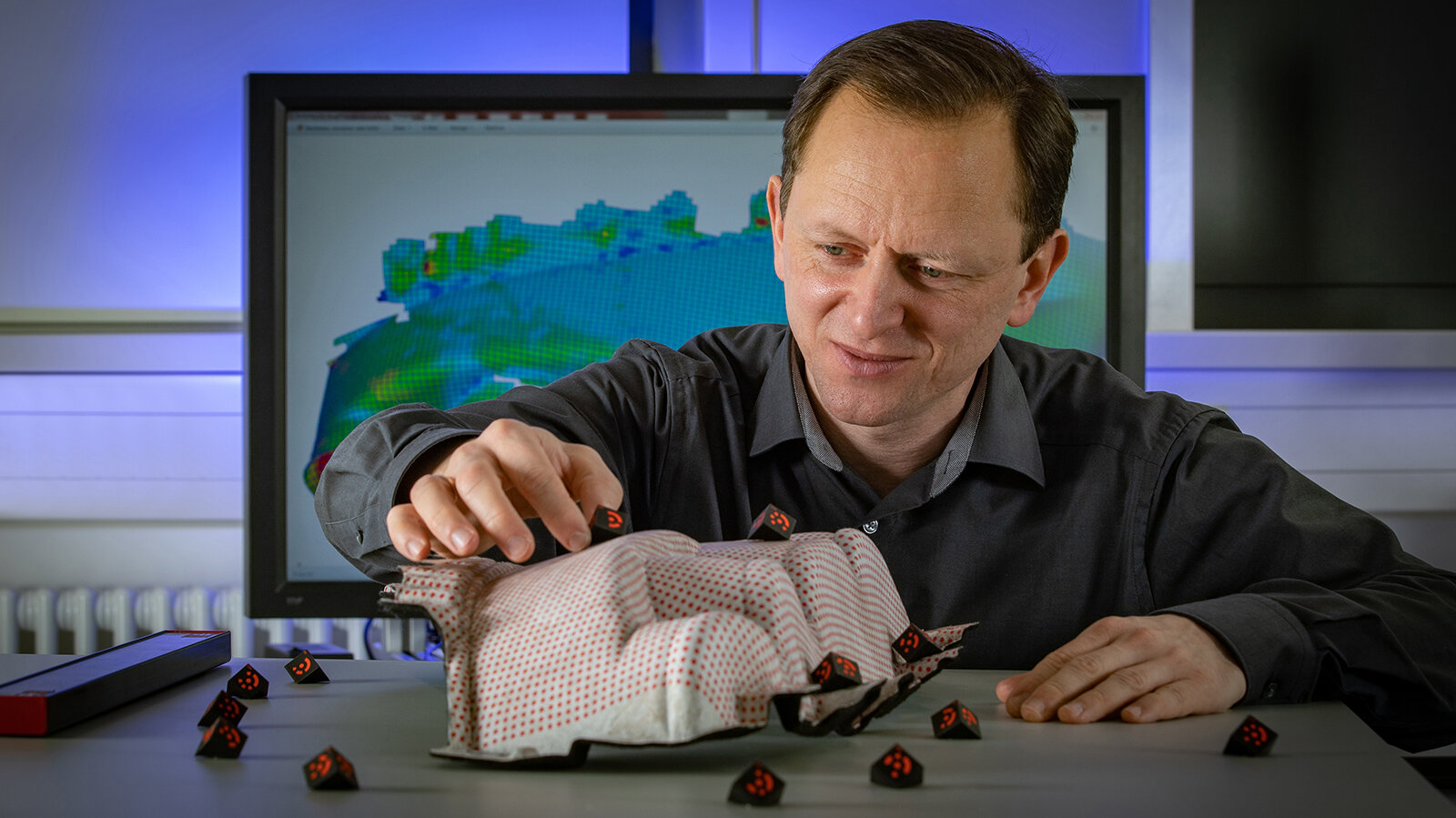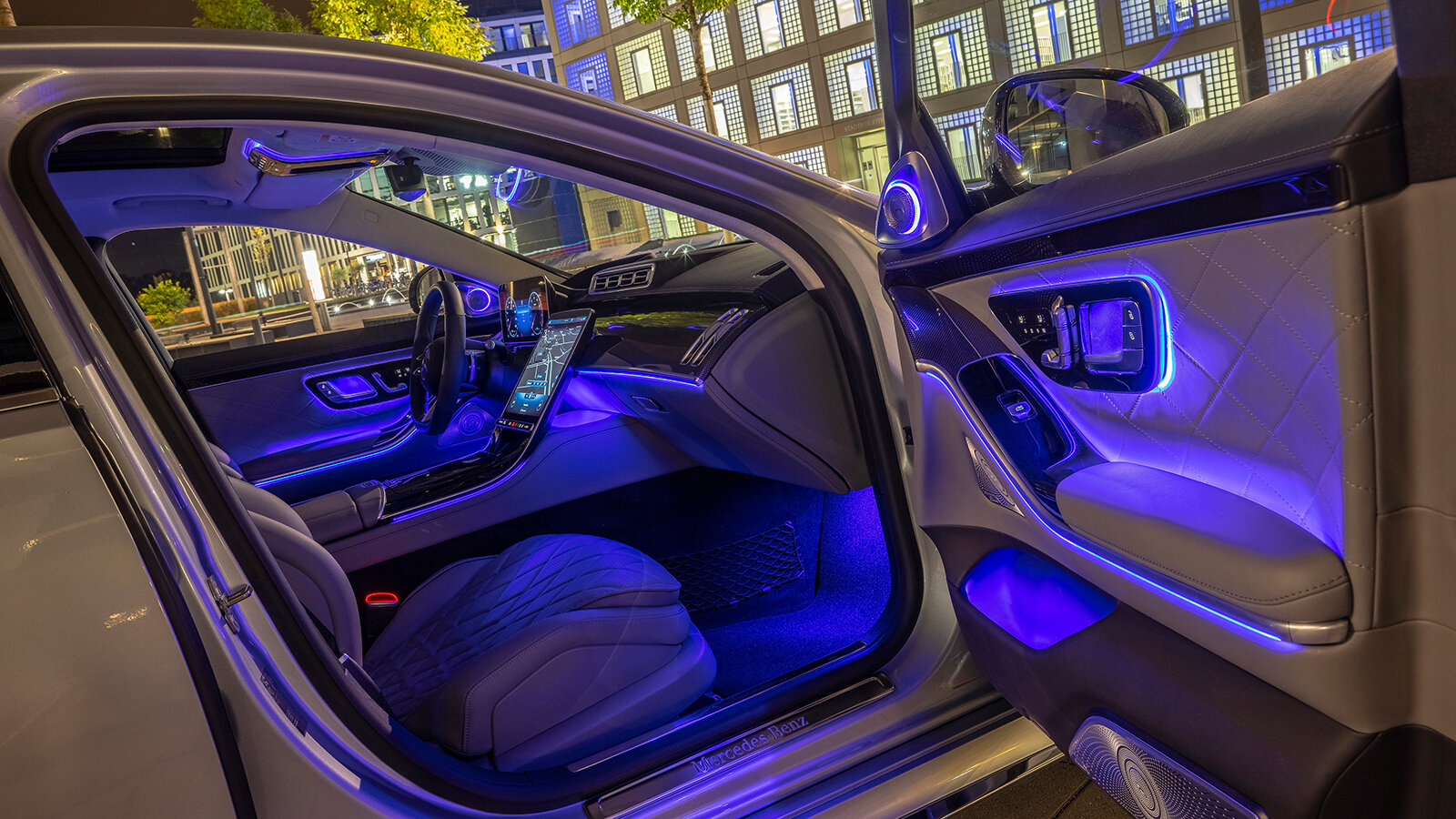Chemnitz University of Technology and Mercedes-Benz cooperate in lightweight construction
Technologies from the Cluster of Excellence MERGE at Chemnitz University of Technology lay foundation for material invention now being used in series production of the new Mercedes-Benz S-Class.
-

MERGE scientist Dr. Roman Rinberg places markers on a prototype of the microsandwich card pocket. A special 3D measurement technique analyzes a 3D point cloud of the scanned surface at the MERGE Research Centre "Lightweight Technologies" using complex mathematical algorithms. Photo: Jacob Müller -

The innovative material was specially developed for the interior of the S-Class. Photo: Daimler AG -

A look inside: the material structure of the microsandwich consists of a PET foam core and cover layers of nonwoven fabric. Photo: Daimler AG
Lightweight design can be defined as the art and science of making things as light as possible. The automotive industry also likes to make use of this art, because the lighter a vehicle, the more sustainable and efficient it is. Mercedes-Benz, for example, is also focusing on lightweight construction in its current S-Class. The comprehensive package of measures for the lowest possible weight also includes a new type of microsandwich material, which the premium vehicle manufacturer developed with the support of the Cluster of Excellence MERGE at Chemnitz University of Technology. This material is used in three places in the S-Class: in the map pockets of the door panels, the parcel shelf, and in the backrest tensioning part of the seat.
The innovative material, which was specially developed for the interior of the S-Class, consists of three components joined together: two thin outer layers and a particularly lightweight core. This principle is called sandwich composite. In case of the Mercedes-Benz microsandwich, it is a foam core that is already partly made of recycled polyethylene terephthalate (PET). The outer layers are made of hybrid glass- or natural fibre-reinforced nonwovens, depending on the component requirements. These individual layers are joined by a hotmelt adhesive film or by mechanical needling, the functional principle of which is similar to that of Velcro fasteners: Multiple individual fibres from the cover layers penetrate the core, anchor themselves in the respective opposite cover layer, and thus form a firm bond.
Numerous test series were carried out at Chemnitz University of Technology in the MERGE Research Centre "Lightweight Technologies" over the course of material development. Dr. Roman Rinberg, MERGE scientist and head of the research area for bioplastics and natural fibre composites at the Department of Lightweight Structures and Polymer Technology (SLK), reports: "The tests we conducted served, among other things, to determine the mechanical characteristics, which are used, for example, to determine the flexural modulus and flexural strength. These performance characteristics provide information on how compliant and strong a material is." In addition, the Lightweight Research Center at Chemnitz University of Technology provided the framework for characterizing the material, which, in the case of heterogeneous sandwich structures like this one, reveals the relationships between structure and properties. In order to finally successfully produce 3D components from the resulting flat material, elaborate simulations and forming tests had to take place and the resulting component had to be analyzed using a special 3D measurement technique. In this way, the actual degree of forming, i.e. the geometric change in the workpiece during the forming process, was determined.
Fibre-plastic composites in the automobile
Fibre-reinforced plastic (FRP) composites, which combine polymers with fibre reinforcement, have been of particular importance in automotive engineering for more than two decades. Natural fibre-reinforced plastics (NFK) have established themselves as a lightweight solution for use in vehicle interiors. For example, a vehicle made in Germany has an average of 3.6 kilograms of natural fibres made from flax, hemp, kenaf or cotton. "Sandwich composite components with lightweight core materials are a promising strategy for further minimizing the weight of structures subject to bending loads," Rinberg says, who goes on to explain, "In automotive interiors, the application of this lightweight construction method poses a particular challenge, as suitable material concepts must meet the requirements of the automotive industry both technologically and economically."
In close collaboration between the researchers from MERGE and the development engineer responsible at Mercedes-Benz, Dr. Christoph Menzel, a corresponding material solution has been developed since 2015. The result is an ecological lightweight sandwich construction concept that saves up to 50 percent in weight compared to conventional components. At the same time, thanks to its good thermoformability, the microsandwich allows the realization of complex applications and improves passenger safety compared to previously used materials, as the high compliance prevents fractures in the material.
The microsandwich composite is manufactured in a single step, in what is known as a one-shot process: compression molding tools with short cycle times perform the consolidation of the nonwovens in a single operation, in which the meltable fibre component is compacted by cooling under pressure, the forming of the tempered sandwich composite and the application of the decoration. The bonding of the individual layers, edge sealing and component trimming also take place in parallel. The use of natural fibres and the weight reduction achieved thanks to the microsandwich concept thus reduce CO2 emissions and energy requirements from the production to the use and disposal phases.
Sustainable Approach to Luxury
The S-Class has always been the spearhead of innovation in the automotive sector. Starting with this vehicle, numerous technologies are also finding application in other model series. "Research and development are key to the corporate success of Mercedes-Benz. Alongside digitalization and electrification, sustainability and environmental protection are among the strategic goals of Mercedes-Benz. For this reason, lightweight construction was also a particular focus in the design of the current S-Class, as the process of resource-conserving development is firmly anchored in vehicle development," says Menzel.
Background: Cluster of Excellence MERGE
Intelligent lightweight design concepts are in demand. In the automotive sector, the need for sustainable and efficient vehicles is underscored by the current discussion on climate change and the population's increased environmental awareness. The scientists at the Cluster of Excellence MERGE at Chemnitz University of Technology recognized this need at an early stage. Since the beginning their activities in 2012, the lightweight construction experts at the cluster have repeatedly dedicated themselves to questions of sustainable mobility, such as adaptations in vehicle architecture or the development of innovative drive systems. For example, numerous interior and exterior structural components have already been created in the automotive sector as part of the research alliance. These include a lightweight wheel disc made of a carbon aluminum foam sandwich composite with a weight reduction of 50 percent, vehicle seats, crash elements, and much more. Research in this area continues in a wide range of current mobility projects.
For more information, contact Dr. Roman Rinberg, phone: +49 371 531-32359, e-mail: roman.rinberg@mb.tu-chemnitz.de.
(Author: Eva Laurie / Mario Steinebach / Translation: Chelsea Burris)
Matthias Fejes
21.06.2021




